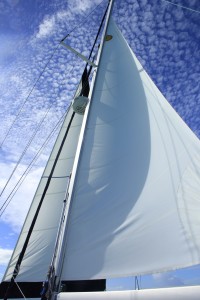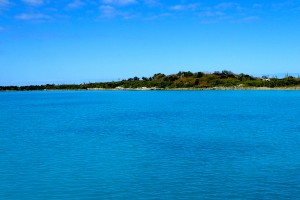A sailboat is a boat (i.e., a hull, a keel, and a rudder) attached to a sail (usually, a main sail and a foresail, and sometimes, also a spinnaker and a staysail). The hull moves forward through the water because of the force of the wind on the sails, counterbalanced by the resistance of the water on the keel. A sailor can make certain adjustments to the direction of the forward motion by trimming the sails or turning the rudder. The sailor cannot, however, make the boat move forward directly into the wind (unless you are sailing in the New York Harbor, where the tidal current is often stronger than the wind and will carry you wherever it wants (e.g., into a ferry terminal) whenever it wants (e.g., when you are racing to make it back into the marina before sunset)). Sailboats have masts (i.e., a lightening rod floating in the water) and sails (i.e., a kite collecting the force of the wind) that make being on the water during a storm precarious at best and usually quite dangerous. And sailboats usually do not have engines with enough power to propel them through the water very fast when the wind is light (and s/v Blue Moon sails faster than she motors). Therefore, relying on a sailboat to get from point A to point B in a timely fashion is like betting on a mule in a horse race.
Being completely dependent on the weather has tested my patience. In my professional life, I was constantly under the gun to do an inordinate amount of work at unconscionable times. Review a 100-page loan agreement at 2 am on Thanksgiving Eve? Of course. Lead a conference call at 5 am on Monday mornings for the month of August? Why not? It engendered in me an (untenable) expectation that everything should happen exactly when I think it should happen. If I can close a deal in the midst of a hurricane that has knocked out power stations and telephone lines, why can’t the rest of the world do its job well in a timely fashion?
And then, perhaps a glutton for punishment, I boarded a sailboat.
My first few sails with the Manhattan Sailing Club were in the early morning in the early summer. Peter Abelman was often the only skipper dedicated enough to show up for the 9 am weekend sails in June. Sailors are known to drink too much and sleep through the first sail of the day, and winds in Manhattan in the early summer mornings are known to be light, if blowing at all (not to mention the roadblocks posed by the dysfunctional New York subway system on the weekends). But Peter would dutifully come down to the docks, load us overeager probies onto the sailboat, pull out of the cove, direct us to hoist the sails, and then bob around in the middle of the river, going wherever the current decided to take us. Peter used the time to teach us to tie knots (until we could do it blindfolded or one-handed) or to tell us stories of ships lost at sea. Peter had been helicoptered off a sinking ship he was helming in the middle of the Atlantic during a storm a decade or two ago, so whenever he saw storm clouds on the horizon or red spots on the radar, he ordered us to drop sails with all speed and head back to the cove. Too little wind, no sailing; too much wind, no sailing. My three-hour window for sailing once a week made the unpredictability of the weather unbearable. I apologize to anyone who was on a conference call with me on a Saturday or Sunday summer afternoon after a thwarted attempt to sail in the morning.
Now, we live on a sailboat attempting to make forward progress toward our waypoint of Grenada on June 1st. We anxiously awaited our departure from New York in January (after apartments were vacated, bonuses were paid, jobs were quit, bags were packed and friends were hugged). And we anxiously awaited our departure from Hope Town this week (after provisions were purchased, hatches were battened and parents were hugged). Monday the wind was from the wrong direction and too light (5 knots out of the south). Tuesday the wind was too strong (30 knots out of the north) and squalls were forecasted. This afternoon, the forecast is for 10-20 knots out of the northwest. We’ll sneak out of a cut in the reef near Elbow Cay just before sunset, and sail overnight to Royal Island off the east coast of Eluthera, arriving just after sunrise.
Listening to the waves wash up the hull, seeing a sky full of stars at an empty anchorage, and knowing we can stay exactly where we are for as long as we want makes the unpredictability of the wind well worth the wait. I can’t say it’s been a direct path to this understanding, but sometimes you have to tack back and forth to learn the necessary lessons. Sail ho!
Land ho! We made it to Royal Island.


